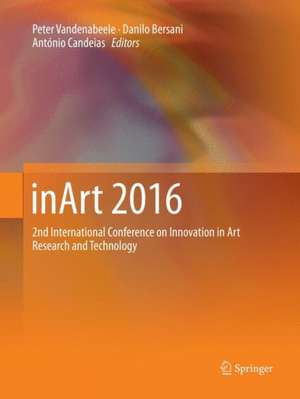inArt 2016 : 2nd International Conference on Innovation in Art Research and Technology
Editat de Peter Vandenabeele, Danilo Bersani, António Candeiasen Limba Engleză Paperback – 13 aug 2018
The topics addressed are amongst others:
- New technological developments
- In vitro experimental set-ups and degradation mechanisms
- In situ experiments and mobile instrumentation
- Non-invasive and non-destructive analysis
- Imaging techniques
- Environmental issues on the preservation of art and archaeological objects
These contributions have previously been published in the journal Applied Physics A , in Volume 122, 2016 and Volume 123, 2017.
| Toate formatele și edițiile | Preț | Express |
|---|---|---|
| Paperback (1) | 1065.58 lei 38-44 zile | |
| Springer Berlin, Heidelberg – 13 aug 2018 | 1065.58 lei 38-44 zile | |
| Hardback (1) | 1096.50 lei 38-44 zile | |
| Springer Berlin, Heidelberg – 11 aug 2017 | 1096.50 lei 38-44 zile |
Preț: 1065.58 lei
Preț vechi: 1402.09 lei
-24% Nou
Puncte Express: 1598
Preț estimativ în valută:
203.89€ • 213.46$ • 168.71£
203.89€ • 213.46$ • 168.71£
Carte tipărită la comandă
Livrare economică 01-07 aprilie
Preluare comenzi: 021 569.72.76
Specificații
ISBN-13: 9783662572320
ISBN-10: 366257232X
Pagini: 401
Ilustrații: VII, 401 p. 284 illus., 200 illus. in color.
Dimensiuni: 210 x 279 mm
Greutate: 0 kg
Ediția:Softcover reprint of the original 1st ed. 2017
Editura: Springer Berlin, Heidelberg
Colecția Springer
Locul publicării:Berlin, Heidelberg, Germany
ISBN-10: 366257232X
Pagini: 401
Ilustrații: VII, 401 p. 284 illus., 200 illus. in color.
Dimensiuni: 210 x 279 mm
Greutate: 0 kg
Ediția:Softcover reprint of the original 1st ed. 2017
Editura: Springer Berlin, Heidelberg
Colecția Springer
Locul publicării:Berlin, Heidelberg, Germany
Cuprins
Shellac/nanoparticles dispersions as protective materials for wood.- Photoluminescence properties of zinc white: an insight into its emission mechanisms through the study of historical artist materials.- Pigment particles analysis with a total reflection X-ray fluorescence spectrometer: study of influence of instrumental parameters.- Characterization of Roman glass tesserae from the Coriglia excavation site (Italy) via energy-dispersive X-ray fluorescence spectrometry and Raman spectroscopy.- Chemical and spectroscopic investigation of the Raphael’s cartoon of the School of Athens from the Pinacoteca Ambrosiana.- A new scanner for in situ digital radiography of paintings.- A structural approach in the study of bones: fossil and burnt bones at nanosize scale.- Characterisation of artificial patinas on bronze sculptures of the Carlo Bilotti Museum (Rome).- In situ Raman spectroscopic study of marble capitals in the Alhambra monumental ensemble.- A first insight on the biodegradation of limestone: the case of the World Heritage Convent of Christ.- The analysis of European lacquer: optimization of thermochemolysis temperature of natural resins.- Insight into Sam Francis’ painting techniques through the analytical study of twenty-eight artworks made between 1946 and 1992.- Radiocarbon dating of twentieth century works of art.- Analysis of Wilhelm Ostwald’s “Colour Organ” with Raman microspectroscopy.- Light, shadows and surface characteristics: the multispectral Portable Light Dome.- A combined approach for the attribution of handwriting: the case of Antonio Stradivari’s manuscripts.- Visualization and quantification of weathering effects on capillary water uptake of natural building stones by using neutron imaging.- Uncover the mantle: rediscovering Gregório Lopes palette and technique with a study on the painting “Mater Misericordiae”.- Gem and mineral identification using GL Gem Raman and comparison with other portable instruments.- Development of a translation stage for in situ noninvasive analysis and high-resolution imaging. - New insights into the painting stratigraphy of L’Homme blessé by Gustave Courbet combining scanning macro-XRF and confocal micro-XRF.- Monitoring the impact of the indoor air quality on silver cultural heritage objects using passive and continuous corrosion rate assessments.- Conquering space with matter: a technical study of Alberto Burri’s materials and techniques.- The corrosion process of sterling silver exposed to a Na2S solution: monitoring and characterizing the complex surface evolution using a multi-analytical approach.- Identification of green pigments from fragments of Roman mural paintings of three Roman sites from north of Germania Superior.- Nondestructive Raman investigation on wall paintings at Sala Vaccarini in Catania (Sicily).- Rehabilitation of farmhouses and barns: limits of salt content.- A whole spectroscopic mapping approach for studying the spatial distribution of pigments in paintings.- Raman microscopy of hand stencils rock art from the Yabrai Mountain, Inner Mongolia Autonomous Region, China.- Non-invasive dendrochronology of late-medieval objects in Oslo: refinement of a technique and discoveries.- Pictorial materials database: 1200 combinations of pigments, dyes, binders and varnishes designed as a tool for heritage science and conservation.- Raman spectroscopic analysis of a belltower commemorative wall decoration.- Dual phylogenetic staining protocol for simultaneous analysis of yeast and bacteria in artworks.- On the conservation of easel paintings: evaluation of microbial contamination and artists materials.- Analytical characterization of glass tesserae from mosaics of early Christian basilicas in Albania.- The comparative study of four Portuguese sixteenth-century illuminated Manueline Charters based on spectroscopy and chemometrics analysis.- The case study of The daughters of the Emperor Ferdinand I by Jakob Seisenegger, in Trento (Italy): analytical hygro-mechanical results as a support in risk assessment for technical interventions.-Prediction and classification of the degradation state of plastic materials used in modern and contemporary art.
Textul de pe ultima copertă
These proceedings result from the 2nd International Conference on Innovation in Art Research and Technology, Ghent, 2016, which aimed to create a bridge of communication between the many disciplinary sectors that contribute to the field of archaeometry. It brings together contributions on conservation and restoration of works of art from chemists, physicists, geologists, art historians, restorers and archaeologists.
The topics addressed are amongst others:
- New technological developments
- In vitro experimental set-ups and degradation mechanisms
- In situ experiments and mobile instrumentation
- Non-invasive and non-destructive analysis
- Imaging techniques
- Environmental issues on the preservation of art and archaeological objects
Caracteristici
Offers selected, peer-reviewed contributions from the inArt 2016 conference
Provides a multidisciplinary approach to archaeometry
Includes supplementary material: sn.pub/extras
Provides a multidisciplinary approach to archaeometry
Includes supplementary material: sn.pub/extras
